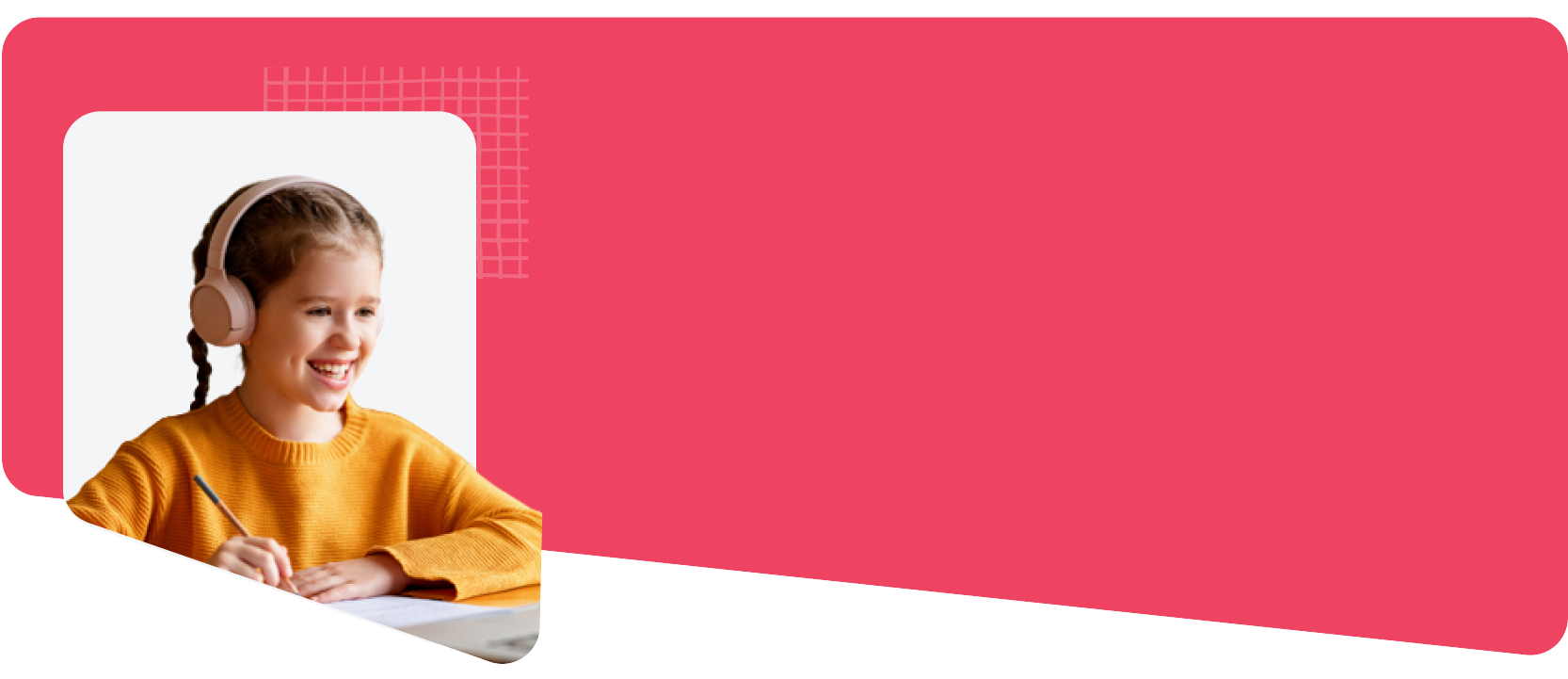What do you think differentiates one human from another? In one of the most accurate senses, it is our fingerprints. No two humans have the same fingerprints and, hence, are unique in their own way. So, we can safely say that there’s no one-size-fits-all way when it comes to education, too.
When we talk about dyslexia, we often forget that every child is unique and has a different way of learning. From Albert Einstein to Pablo Picasso and Walt Disney to Agatha Christie, some of the great personalities in the world have made their way out of their learning difficulties and made a name for themselves.
If you’re a parent of a child with dyslexia, you already know that learning to read and write doesn’t come easily for them. You’ve probably watched them struggle through schoolwork that seems straightforward for their peers, and maybe you’ve even heard them say things like, "I hate reading" or "I’m just not smart enough."
The truth is that dyslexia is not about intelligence, but about learning differently. And with the right support, your child can develop skills, gain confidence, and discover their unique strengths.
In this blog, we’ll walk you through the challenges dyslexic learners face, the strengths they bring to the table, and how to find the best dyslexia tutoring in Australia. Let’s go!
Understanding Dyslexia: Challenges and Strengths
Dyslexia is one of the most common learning differences, affecting how the brain processes written and spoken language. For children, especially in school settings, dyslexia can feel like a constant uphill battle. However, while reading and writing may be difficult, dyslexia also brings unique strengths that often go unnoticed.
The Learning Struggles of Dyslexic Children
For children with dyslexia, everyday tasks like reading a book, writing a sentence, or spelling a word correctly can be frustrating.
-
Struggling with Phonics: Dyslexic children often find it hard to connect letters with sounds, making it difficult to decode words. They may struggle to differentiate similar letters (like "b" and "d") or remember spelling patterns, affecting their reading and writing fluency.
-
Slow and Effortful Reading: Reading can feel like a slow, exhausting process because dyslexic learners don’t recognize words automatically. They often lose their place, reread sections, or struggle to comprehend texts because decoding each word takes extra effort.
-
Spelling Struggles: Even after repeated practice, dyslexic learners may forget how to spell words or spell them differently each time. This inconsistency is frustrating, especially in school settings where spelling tests and written assignments are frequent.
-
Low Confidence and Self-Esteem: Dyslexic children often feel "not smart enough" compared to their peers, leading to anxiety and frustration in the classroom. Without proper support, these struggles can affect their confidence, participation, and overall enjoyment of learning.
These challenges can make traditional classroom learning frustrating. But what if we flipped the perspective?
Also Read: Engaging Activities for Autistic Kids: Boosting Sensory and Fine Motor Skills
The Strengths of Dyslexic Thinkers
While dyslexia presents learning difficulties, it also fosters abilities that traditional school environments don’t always recognize. Many dyslexic individuals excel in creative, hands-on, and strategic thinking.
-
Creative Problem-Solving: Dyslexic children often think in innovative ways, coming up with unique solutions to problems. Their ability to see different perspectives makes them great at hands-on learning, puzzles, and real-world challenges.
-
Big-Picture Thinking: Rather than focusing on small details, dyslexic thinkers excel at seeing connections between ideas. This skill helps them grasp complex concepts quickly, making them strong strategists and visionaries.
-
Strong Visual-Spatial Skills: Many dyslexic individuals have exceptional visual-spatial awareness, thriving in areas like art, design, engineering, and sports. They process images and patterns effectively, making them natural creators and problem solvers.
-
Resilience and Determination: Dyslexic learners work harder to overcome challenges, developing strong perseverance and adaptability. Their experiences with early struggles often make them more determined, resourceful, and empathetic.
So, we can now say that teaching dyslexic students is a lot about flipping the perspective and focusing on their strengths. Let’s see how dyslexia tutoring works and what you should expect from it.
Also Read: Sensory Seeking Activities for Kids
Dyslexia Tutoring in Australia: What Works Best?
Many children with dyslexia don’t benefit from standard classroom methods. They need explicit, structured, and multisensory approaches that help them break down language in a way that makes sense. Here are some of the most effective dyslexia tutoring methods.
-
Multisensory Structured Literacy Programs
Multisensory programs engage sight, sound, touch, and movement to reinforce learning. By involving multiple senses, like tracing letters or listening to sounds, these approaches help dyslexic children better retain information and improve reading and spelling skills.
-
Phonics-Based Approaches
Phonics-based methods provide systematic instruction on letter-sound relationships, helping dyslexic learners break down words into smaller, manageable parts. This makes decoding easier and reading less overwhelming.
-
Assistive Technology
Tools like audiobooks, text-to-speech software, and speech-to-text apps can make reading and writing tasks more accessible. These technologies offer alternative ways to process text, supporting learning and reducing frustration.
-
Repetition and Practice
Dyslexic children often need more repetition and practice to master skills. Regular exposure to new concepts and review of previously learned material helps reinforce understanding and build confidence.
Now that you know what to look for in dyslexia tutoring, let’s check out some popular services in Australia.
Best Dyslexia Tutoring Programs in Australia
For parents seeking professional support, several well-regarded dyslexia tutoring programs across Australia provide specialized help to customize to individual needs. Here are some top options:
-
SPELD NSW & SPELD Victoria
SPELD organizations in New South Wales and Victoria are dedicated to supporting students with specific learning difficulties like dyslexia. They offer expert tutoring, assessments, and resources focused on structured literacy methods. These programs help children improve their reading and writing skills while providing families with valuable tools and strategies to support learning at home.
-
Learning Links
Learning Links offers evidence-based literacy programs that focus on helping children with dyslexia and other learning challenges. Their expert tutors use systematic, structured approaches to enhance reading, writing, and spelling abilities, ensuring students receive targeted support to meet their learning goals.
-
DSF Literacy & Clinical Services (WA)
Based in Western Australia, DSF Literacy & Clinical Services provides expert literacy support for children struggling with dyslexia. They offer tailored tutoring programs, assessments, and professional development resources to help both students and educators. Their evidence-based approaches are designed to address the specific needs of dyslexic learners, helping them build confidence and succeed academically.
-
Private Dyslexia Specialists
Many private tutors in Australia are trained in structured literacy programs like Orton-Gillingham, which have been shown to be effective for dyslexic learners. These specialists provide one-on-one sessions, focusing on individualized instruction that aligns with each child’s unique learning pace and needs.
-
Online Tutoring
Online tutoring is growing rapidly, offering flexible access to high-quality dyslexia support no matter where you live. Whether through virtual one-on-one sessions or specialized online programs, these options make it easier for families in remote or underserved areas to find expert tutoring tailored to their child's needs.
Meanwhile, from these options, you need to look for the best fit for your child. Let’s see how to do that.
Also Read: Understanding Why Children Write Letters Backwards
Finding the Right Dyslexia Tutor in Australia
When searching for a dyslexia tutor, it’s essential to find someone who can provide the right type of support for your child’s specific learning needs. Here are key factors to consider:
-
Experience with Dyslexia
Choose tutors trained in structured literacy methods, like Orton-Gillingham, who have experience working with dyslexic learners. This ensures they can effectively address your child’s specific needs.
-
Use of Multisensory Strategies
Dyslexic children learn best when multiple senses are engaged. A good tutor will use multisensory techniques, such as combining visual, auditory, and tactile exercises to strengthen reading and spelling skills.
-
Patience and Encouragement
Learning should boost confidence, not cause stress. Look for a tutor who is patient, supportive, and creates a positive, encouraging environment where your child feels motivated to improve.
-
Research-Backed Methods
Ensure the tutor uses evidence-based, research-backed strategies. Avoid quick-fix methods that may provide temporary solutions without long-term effectiveness.
-
NDIS Funding
Many parents explore NDIS funding to help cover tutoring costs. If eligible, this can make professional dyslexia support more accessible.
Looking for tutoring is one option, while you can also help your child at home. Here are some tips to support your child.
How Parents Can Support Dyslexic Learners at Home
As a parent, you are your child's greatest advocate. While professional support is essential, there are many things you can do at home to help them thrive. Here are some practical ways to support your dyslexic learner:
-
Read Together Without Pressure
Reading together can be a great bonding activity, and it doesn’t have to be stressful. Use audiobooks or read aloud together, allowing your child to follow along without the pressure of having to read every word correctly. This can make stories more enjoyable and less daunting, helping to build a love for books.
-
Use Technology to Your Advantage
There are plenty of apps and tools designed to assist with reading and writing. Many tools can read text aloud, offer word predictions, or even help with speech-to-text, making tasks more manageable and less frustrating for dyslexic learners.
-
Praise Effort, Not Just Results
Focus on the effort your child puts in rather than just the outcome. Celebrate their persistence and progress, even when it’s small. This helps build their confidence and encourages a growth mindset, reinforcing the idea that success comes from effort, not perfection.
-
Encourage Creativity
Dyslexic children often excel in creative fields like art, music, coding, or other hands-on activities. Encourage them to explore these areas where they can shine. Allowing your child to express themselves through different mediums boosts their self-esteem and shows them they have unique talents and abilities.
-
Remind Them That Dyslexia Doesn’t Define Them
Above all, let your child know that being dyslexic doesn’t mean they are less capable. It just means they think differently, and that’s a strength. Help them understand that their brain processes information in a unique way, and many successful people share this trait.
Conclusion
Just as no two fingerprints are the same, no two learning paths are identical. Each child, including those with dyslexia, has their own way of processing the world and learning new things. While dyslexia can present challenges, it also brings unique strengths, from creativity to problem-solving, that can help children thrive in their own time.
As a parent, you’re already the best advocate for your child. With the right support, tools, and approach, your child can welcome their learning journey with confidence. Remember, dyslexia doesn’t mean less capability; it simply means thinking differently. With patience, understanding, and the right resources, your child has everything they need to succeed.
So, keep supporting them, keep celebrating their strengths, and always remind them that their learning difference is just a part of what makes them unique.










